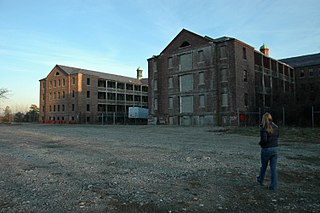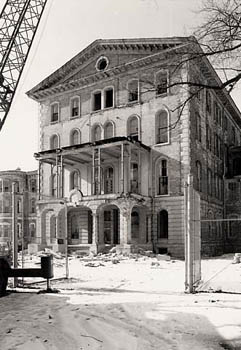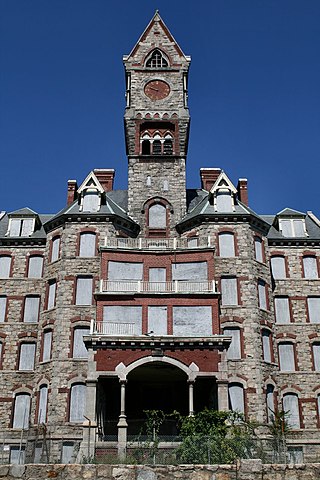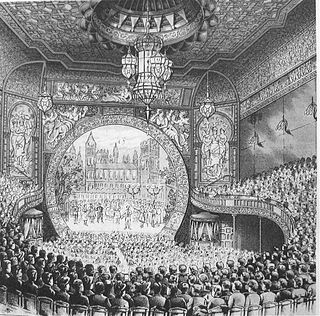Related Research Articles

Mattapan is a neighborhood in Boston, Massachusetts, United States. Mattapan is the original Native American name for the Dorchester area, possibly meaning "a place to sit." At the 2010 census, it had a population of 36,480, with the majority of its population immigrants.
The Pleasant Street incline or Pleasant Street portal was the southern access point for the Tremont Street subway in Boston, Massachusetts, which became part of the Green Line after the incline was closed. The portal and the section of tunnel connecting it to Boylston served streetcars from 1897 to 1901, Main Line Elevated trains from 1901 to 1908, and streetcars again from 1908 to 1962. The Pleasant Street incline is now abandoned, but plans have been floated at various times to reuse it.

Austin State Hospital (ASH), formerly known until 1925 as the Texas State Lunatic Asylum, is a 299-bed psychiatric hospital located in Austin, Texas. It is the oldest psychiatric facility in the state of Texas, and the oldest continuously operating west of the Mississippi River. It is operated by the Texas Health and Human Services Commission.

The Danvers State Hospital, also known as the State Lunatic Hospital at Danvers, The Danvers Lunatic Asylum, and The Danvers State Insane Asylum, was a psychiatric hospital located in Danvers, Massachusetts. It was built in 1874 and opened in 1878, under the supervision of prominent Boston architect Nathaniel Jeremiah Bradlee, on an isolated site in rural Massachusetts. It was a multi-acre, self-contained psychiatric hospital designed and built according to the Kirkbride Plan.

Taunton State Hospital is a psychiatric hospital located on Hodges Avenue in Taunton, Massachusetts. Established in 1854, it was originally known as the State Lunatic Hospital at Taunton. It was the second state asylum in Massachusetts. Most of the original part of the facility was built in a unique and rare neo-classical style designed by architects Boyden & Ball. It is also a Kirkbride Plan hospital and is located on a large 154-acre (62 ha) farm along the Mill River.

Wood Island station is an MBTA Blue Line rapid transit station located off Bennington Street in the Day Square section of East Boston, Boston, Massachusetts. The station is adjacent to and named for the former Wood Island Park, a once heavily used recreational area for East Boston residents. Most of the park was destroyed in the mid 1960s to expand Logan International Airport. It was built in 1952, replacing a pair of Boston, Revere Beach and Lynn Railroad stations that served the area.

Harrisburg State Hospital, formerly known from 1851 to 1937 as Pennsylvania State Lunatic Hospital, in Harrisburg, Pennsylvania, was Pennsylvania's first public facility to house the mentally ill and disabled. Its campus is located on Cameron St. and Arsenal Blvd, and operated as a mental hospital until 2006.

The Massachusetts Society for the Prevention of Cruelty to Animals-Angell Animal Medical Center (MSPCA-Angell) is a 501(c)(3) non-profit organization with its main headquarters on South Huntington Avenue in the Jamaica Plain neighborhood of Boston, Massachusetts. It was founded in 1868, and is the second-oldest humane society in the United States. "MSPCA-Angell" was adopted as the society's identity in 2003, and indicates the names of its two closely related predecessor organizations: Massachusetts Society for the Prevention of Cruelty to Animals and Angell Animal Medical Center. The organization provides direct care to thousands of homeless, injured, and abused animals each year, and provides animal adoption, a veterinary hospital, advocacy, and humane law enforcement.

Northampton State Hospital was a historic psychiatric hospital at 1 Prince Street on top of Hospital Hill outside of Northampton, Massachusetts. The hospital building was constructed in 1856. It operated until 1993, and the building was added to the National Register of Historic Places in 1994.

The Boston Psychopathic Hospital, established at 74 Fenwood Road in 1912, was one of the first mental health hospitals in Massachusetts, United States. The building was listed on the National Register of Historic Places in 1994. The name was changed to Massachusetts Mental Health Center in the late 1960s. The building at 74 Fenwood Road was closed in 2010 and demolished in 2011. The Massachusetts Mental Health Center continues to operate at 75 Fenwood Road.

The Elgin Mental Health Center is a mental health facility operated by the State of Illinois in Elgin, Illinois. Throughout its history, Elgin's mission has changed. At times, it treated mental illness, tuberculosis, and provided federally funded care for veterans. The hospital's site, which included a patient-staffed farm reached a maximum of 1,139 acres (461 ha) after World War II. Its maximum population was reached in the mid 1950s with 7,700 patients. Between 1993 and 2008, most of the older buildings in the complex were demolished due to being in poor condition as the result of being abandoned for decades. The site is/was popular among teens and in the paranormal world due to its claims of hauntings in the older buildings and the hospital's cemetery.
Norwood Hospital was a small for-profit community hospital in Norwood, Massachusetts. A member of Steward Health Care, the hospital was evacuated and closed after a significant June 2020 rainstorm led to destructive flooding. While reconstruction was started to reopen the hospital, work halted in February 2024 amid reports of financial instability and unpaid bills across the Steward Health Care System.

Worcester State Hospital was a Massachusetts state mental hospital located in Worcester, Massachusetts. It is credited to the architectural firm of Weston & Rand. The hospital and surrounding associated historic structures are listed as Worcester Asylum and related buildings on the National Register of Historic Places.

The Bijou Theatre (1882–1943) in Boston, Massachusetts, occupied the second floor of 545 Washington Street near today's Theatre District. Architect George Wetherell designed the space, described by a contemporary reviewer as "dainty." Proprietors included Edward Hastings, George Tyler, and B.F. Keith. Around the 1900s, it featured a "staircase of heavy glass under which flowed an illuminated waterfall." The Bijou "closed 31 December 1943 and was razed in 1951." The building's facade still exists. It is currently a pending Boston Landmark by the Boston Landmarks Commission.

Cranberry Specialty Hospital was a tuberculosis sanatorium and later a chronic care facility in Hanson, Massachusetts operated by Plymouth County, Massachusetts, which was operational from 1919 until 1992.
Beacon Park Yard was a CSX Transportation rail yard in Allston, Boston, now owned by Harvard University. The yard opened in 1890 on the site of a former trotting park, from which it took its name. It was closed in 2013 following the relocation of the yard's container operations to Worcester, Massachusetts and opening of a transload facility in Westborough, Massachusetts. Plans for the yard include relocation of the Massachusetts Turnpike Allston exit, construction of a new MBTA commuter rail station, a major real estate development, and possibly a rail layover yard.

The North Cambridge carhouse is a bus garage for trolleybuses, and a former streetcar carhouse, in Cambridge, Massachusetts, which is owned and operated by the Massachusetts Bay Transportation Authority (MBTA). It was first built in 1874. The current structure dates from 1979 and is located in the North Cambridge neighborhood at 2375 Massachusetts Avenue. It is one of two MBTA garages used in operation of the Boston-area trolleybus system.

St Matthew's Hospital, formerly known as the Burntwood Asylum, was a mental health facility in Burntwood, Staffordshire, England. Founded as the Second Staffordshire County Asylum in 1864, it was one of three lunatic asylums built in the county of Staffordshire. The plan was for the asylum to house 500 patients, but it was later expanded to provide a capacity for 1302 beds. The asylum complex included the main facility, an electricity plant, gas works, bakery, fire department, farm, mortuary, landscaped and vegetable gardens and cemetery.

The Royal Dundee Liff Hospital, previously known as Dundee Lunatic Asylum and Dundee Royal Lunatic Asylum, was a mental health facility originally established in 1812 in Dundee, Scotland. It was originally located in premises in Albert Street Dundee, but later moved out of the town to new buildings in the nearby parish of Liff and Benvie. Buildings at Liff included Greystanes House, which was the main building, and, Gowrie House, which was the private patients' facility. Both Grade B listed buildings.
References
- ↑ Preer, Robert (8 July 2007). "Specters of old state hospitals vanish as new uses take shape". The Boston Globe . Retrieved 27 June 2012.
- ↑ "Boston Lunatic Hospital | ArchivesSpace Public Interface".
- ↑ "Boston State Hospital - Social Networks and Archival Context".
- ↑ "Home". HRP Boston. Archived from the original on 2024-12-16. Retrieved 2024-12-30.
- ↑ "Boston State Hospital - Social Networks and Archival Context".